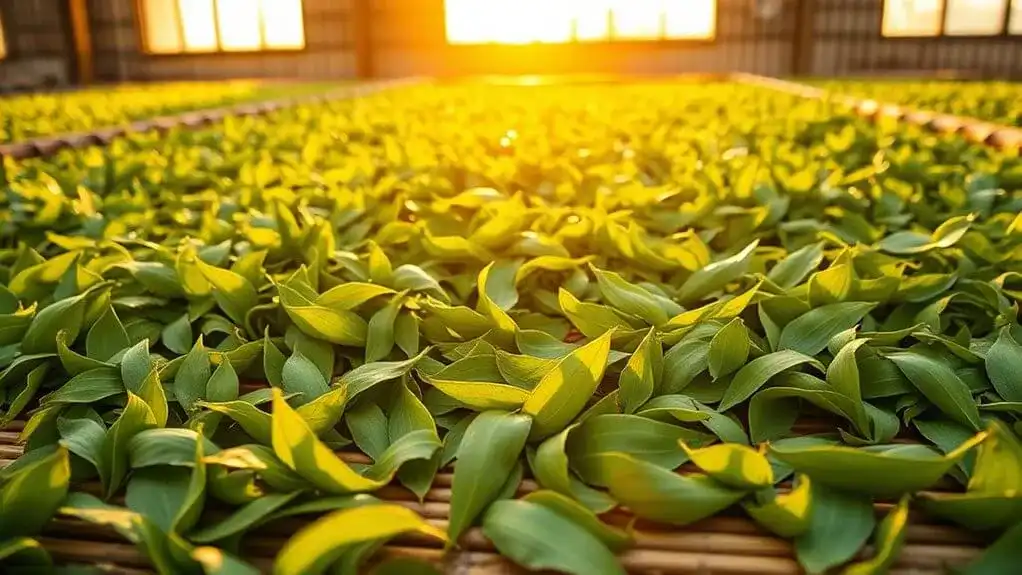Tea withering sets the essential foundation for processing by reducing leaf moisture from 80% to 50-60% through controlled drying. During this first stage, significant chemical transformations occur as proteins break down into amino acids and polyphenols convert into flavor compounds. The process softens leaves for rolling while increasing enzymatic activity that develops distinctive aromas and tastes. Understanding the nuances of withering techniques reveals the key to producing exceptional tea quality.
Key Points
- Withering reduces leaf moisture from 80% to 50-60%, making leaves pliable and preventing damage during subsequent processing steps.
- The process initiates crucial biochemical changes, breaking down proteins into amino acids and transforming polyphenols for better flavor development.
- Controlled withering environments maintain optimal temperature (25-30°C) and humidity (50%) for consistent quality results.
- Different tea types require specific withering methods and durations, from brief periods for green tea to extended withering for white tea.
- Proper withering concentrates leaf juices and weakens cell walls, enhancing flavor extraction and facilitating better polyphenol expression.
What Is Tea Withering and Why Does It Matter?
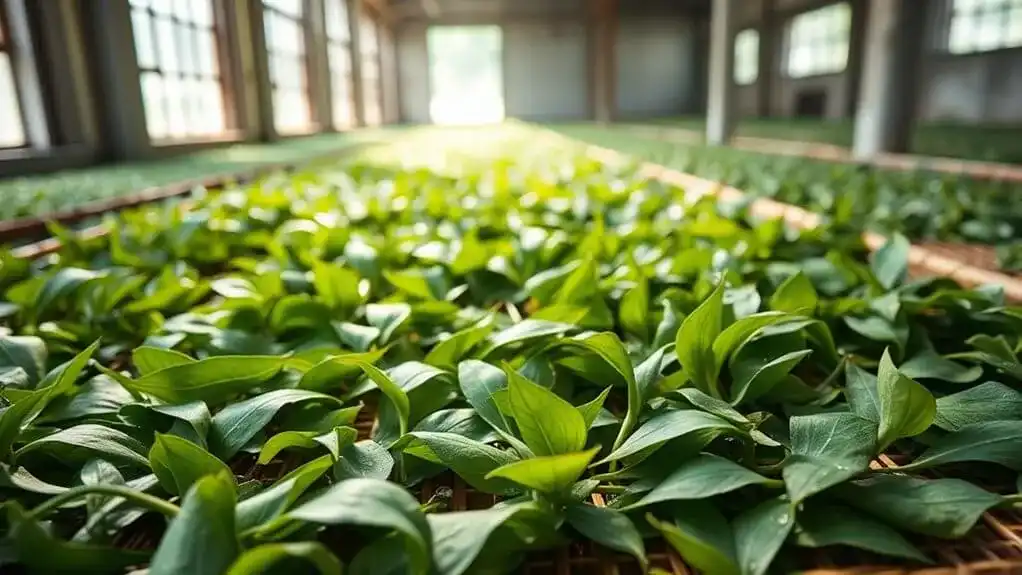
Tea withering marks the vital first step in tea processing, where freshly plucked leaves undergo a controlled loss of moisture. From the moment of leaf selection, the withering process begins naturally, but tea producers carefully monitor and control it to achieve specific outcomes. The process targets reducing moisture to achieve a 50 to 60 percent level in the leaves. Understanding tea origins helps explain why this step is so important – it's where the foundation for flavor development starts. Some tea producers still use bamboo mats in traditional outdoor withering for optimal results.
During withering, leaves lose about one-third to one-half of their moisture content, becoming soft and pliable. This transformation isn't just physical; it triggers important chemical changes too. The process develops essential aroma compounds while breaking down cell walls, which initiates oxidation. Tea makers often use heated forced air to regulate the withering environment for optimal results. Proper withering prevents leaf damage during rolling and guarantees the right conditions for flavor development, making it a critical determinant of the final tea quality.
The Science Behind the Withering Process
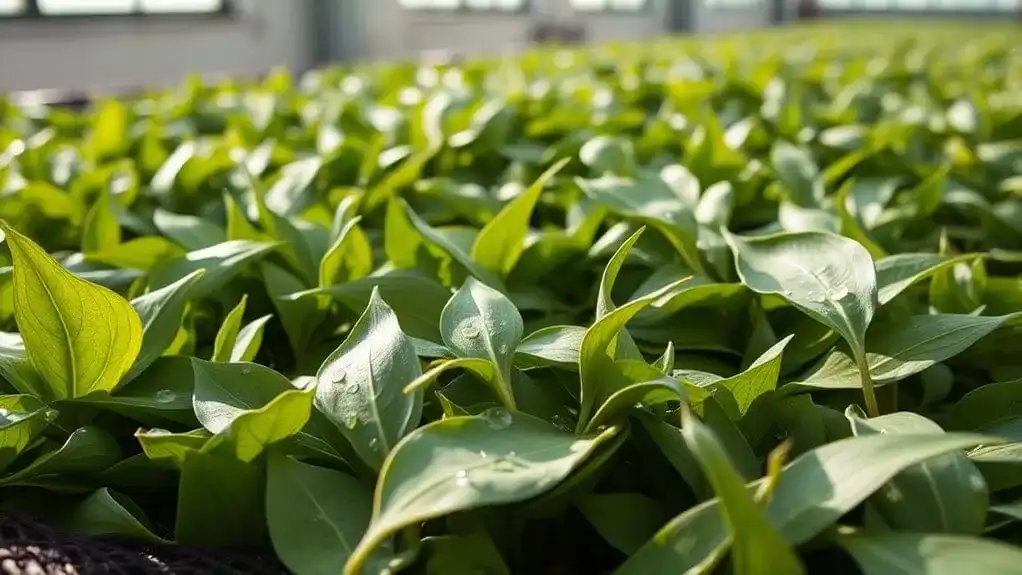
While moisture loss characterizes the visible changes during withering, a complex series of biochemical transformations occurs beneath the surface. As tea leaves lose one-third to one-half of their moisture content, their cellular structure undergoes significant changes, making them more pliable and easier to process. Volatile compounds are actively released during this time, developing the tea's distinctive aroma profile.
During this critical phase, proteins break down into amino acids, and polyphenols begin their transformation, both contributing to flavor development. Research has shown that hydrolytic enzyme activity increases as moisture content decreases during withering. Chlorophyll degradation occurs simultaneously, while caffeine levels increase, particularly in the first 18 hours. Research shows that a 16-hour withering period offers ideal results, as extending beyond this timeframe can compromise tea quality. Research has demonstrated that the quality of tea is directly impacted by plucking standards, with coarse plucking resulting in reduced catechin levels.
Modern innovations, such as UV-C irradiation and ethylene treatments, are enhancing the traditional withering process by accelerating flavor compound accumulation and improving overall efficiency.
Natural vs. Controlled Withering Methods

Building on our understanding of withering's biochemical processes, manufacturers today employ two primary methods: natural and controlled withering. Natural withering involves spreading freshly plucked leaves in shaded outdoor areas, where they wilt naturally over several hours to days, depending on weather conditions and tea variety. White teas, for instance, typically undergo this process for up to three days to develop their distinct flavor profile. Similar to how optimal temperature of 50°C affects chemical changes in cellulose processing, controlled withering conditions must be carefully maintained for ideal results. The careful process helps reduce moisture and prepares leaves for proper oxidation stages. During this phase, enzyme activity initiates the transformation of complex compounds into simpler components, contributing to the tea's final flavor profile.
Controlled withering, in contrast, takes place in managed environments where producers monitor temperature, humidity, and airflow. Using bamboo mats or troughs, sometimes with forced air, this method typically requires 12-18 hours. While natural withering remains at the mercy of weather, controlled withering offers more precise management of moisture loss and chemical changes, making it particularly effective for teas requiring specific processing parameters.
Physical Transformations During Withering
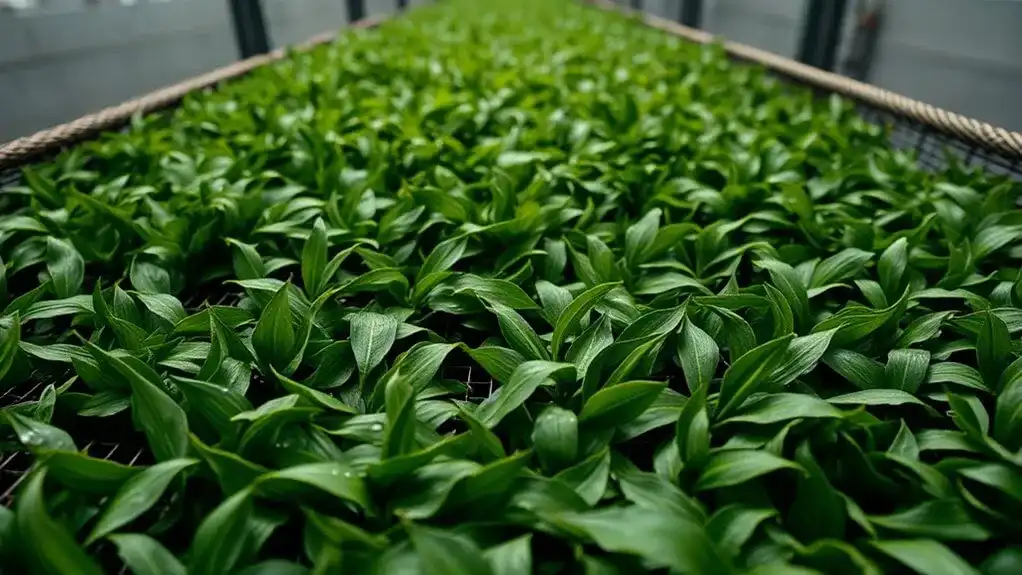
During the withering process, leaves undergo dramatic physical changes that fundamentally alter their structure and composition. The most significant transformation involves leaf hydration, as moisture content drops from 80% to 50-60%. This reduction weakens the structural integrity of cell walls, making leaves more pliable and easier to process in subsequent steps. Modern facilities often employ e-sensing technologies to monitor moisture levels and optimize the withering process in real-time.
Key physical transformations include:
- Decreased turgor pressure, causing leaves to become flaccid
- Enhanced leaf flexibility for better rolling and twisting
- Concentrated leaf juices due to moisture reduction
- Weakened cell walls that facilitate better polyphenol expression
- Improved resistance to crushing during processing
These changes are critical for achieving the desired quality in the final tea product. Different withering methods, from natural air exposure to controlled trough systems, can be employed to achieve these transformations effectively.
Chemical Changes That Shape Tea's Character
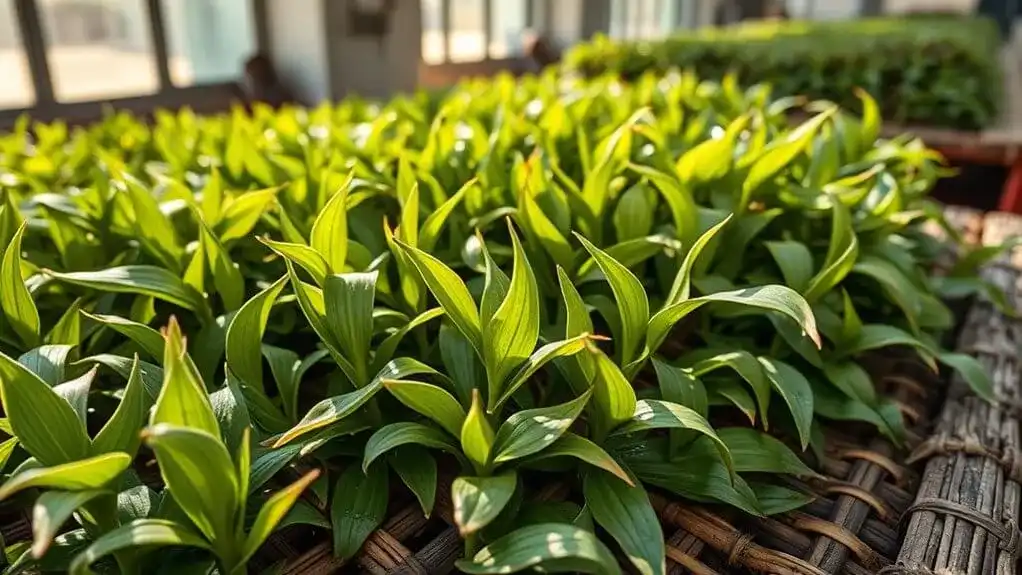
Throughout the withering process, tea leaves undergo complex biochemical transformations that profoundly influence their final character. These chemical transformations start with increased enzymatic activity, particularly from peptidase and polyphenol oxidase enzymes, which break down proteins into amino acids and complex carbohydrates into simpler sugars.
The process triggers significant changes in the leaves' composition: caffeine content rises, chlorophyll degrades by about 15%, and polyphenols transform into theaflavins and thearubigins. Simultaneously, carbohydrates reduce to various phosphate forms, while free amino acids like aspartic acid, glutamic acid, and serine increase significantly. Some sugars metabolize into organic acids, including citric and oxalic acid. These intricate chemical changes directly affect the tea's final flavor, body, and overall quality, making withering a vital foundation for successful tea processing.
Mastering the Art of Proper Withering Techniques
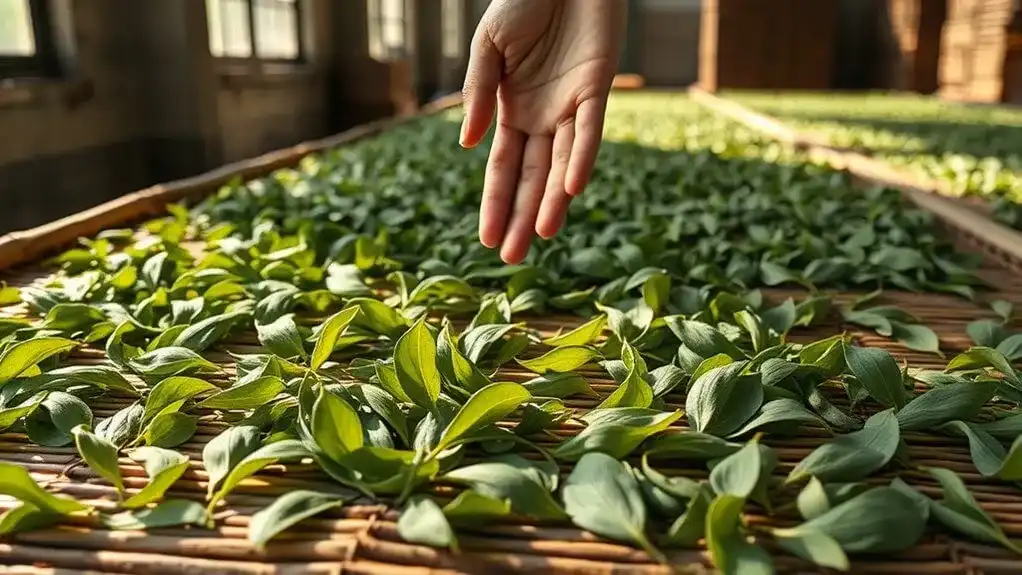
Tea producers employ four primary withering techniques to achieve perfect moisture reduction and chemical transformation in tea leaves. Natural withering exposes leaves to dry air for 23-25 hours, while tat withering enhances this process with controlled air circulation. Trough withering, the industry's most popular method, completes the process in 8-18 hours, offering flexibility and simplicity. For maximum efficiency, tunnel withering uses hot air blasts to complete the process in just 3-5 hours. Modern machines utilize stagger-distributed screws on drum walls to ensure even leaf distribution during mechanical withering. The innovative WIZARD system requires 50% less space than traditional withering methods while maintaining optimal results.
- Temperature control at 25-30°C guarantees peak moisture reduction
- Proper air circulation prevents over-drying and maintains uniformity
- Leaf thickness directly impacts withering duration
- Humidity levels around 50% facilitate perfect moisture loss
- Continuous monitoring helps achieve desired chemical transformations
The withering duration varies greatly between methods, but each technique serves specific production needs while maintaining tea quality.
How Withering Influences Final Tea Quality
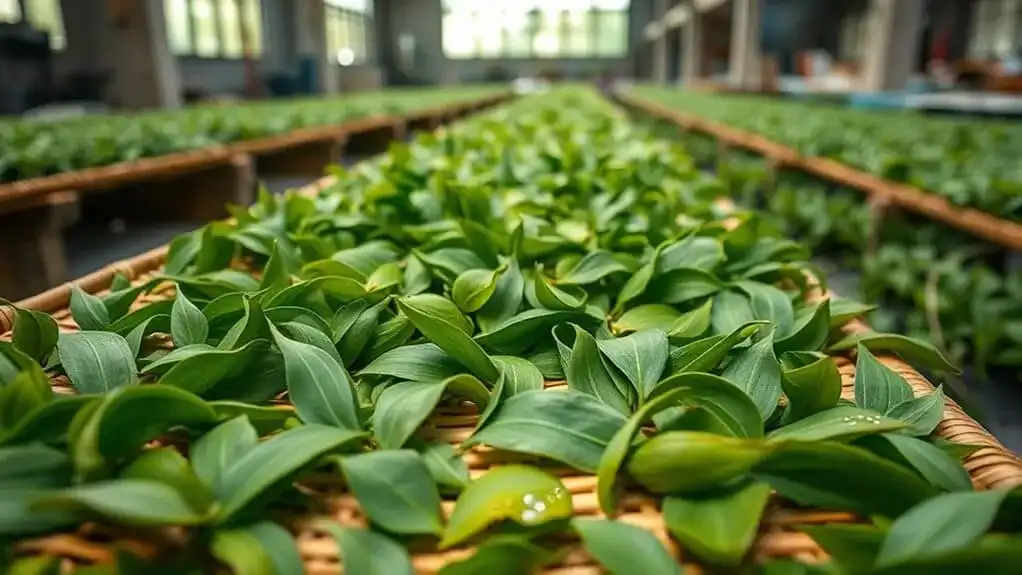
While experienced tea producers carefully monitor the withering process, its influence on final tea quality extends far beyond simple moisture reduction. The process fundamentally transforms the tea's chemical composition, leading to distinct flavor profiles and aroma enhancement. Laying leaves on mats is the traditional approach still valued by many producers today. Withering promotes the breakdown of complex compounds into volatile flavor compounds, while increasing amino acids and monosaccharides that contribute to the tea's overall taste. Proper ventilation and humidity control during withering is crucial to achieve optimal moisture distribution and prevent quality defects. Research shows that shaking withering produces the highest sensory evaluation scores with prominent floral and fruity aromas.
Different withering methods yield varying results: sunlight withering boosts terpenoids and nucleotides, while trough withering increases phenolic acids and flavonoids. The process also affects physical properties, making leaves pliable for processing while preventing uneven drying and mold formation. Each tea type requires specific withering conditions – from the brief process for green tea to preserve freshness, to the extended period for white tea to develop its characteristic sweetness.
Conclusion
Like a flower gracefully releasing its moisture to the morning sun, tea leaves undergo essential physical and chemical transformations during the withering process. This vital first step sets the stage for all subsequent processing phases, determining the tea's final character and quality. When executed properly, withering creates the ideal foundation that allows tea makers to craft their desired flavors and aromas with precision and expertise.
